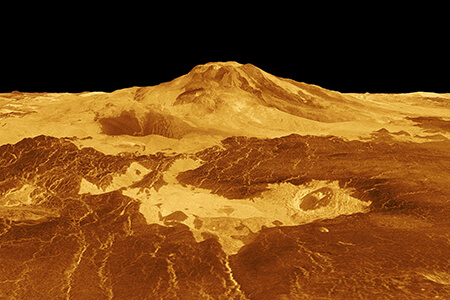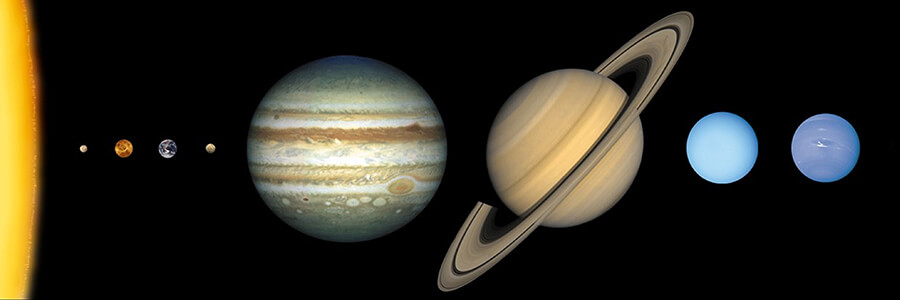This is a lesson summary. The full lesson can be viewed by purchasing an online course subscription.
Learning Objective
In this lesson we will learn about the eight planets in our solar system.
Learning Outcomes
By the end of this lesson you will be able to:
- Discuss general characteristics of the eight planets, including descriptions of their appearance, composition, atmosphere, weather, seasonality and any other distinguishing characteristics.
- Compare terrestrial planets and giant planets.
- Compare the other seven planets to Earth.
- Distinguish between planets and dwarf planets and explain why Pluto is now classified as the latter.

(Image: NASA)
Lesson Summary
- A planet is an object that orbits the Sun, has a spherical shape and has no objects of a similar size near its orbit.
- The planets of the inner solar system – Mercury, Venus, Earth and Mars – are known as the terrestrial planets.
- These are rocky or metallic planets with a core, mantle and crust.
- The planets of the outer solar system – Jupiter, Saturn, Uranus and Neptune – are known as the giant planets.
- These planets lack solid surfaces as they are composed of gases or fluid mixtures of ice and other materials.
- Giant planets are much larger and further apart than terrestrial planets. They also contain ring systems and have many moons, whereas terrestrial planets lack ring systems and have few or no moons.
- Mercury is the closest planet to the Sun and the smallest planet in the solar system.
- It is composed mostly of iron and nickel and has a cratered surface similar to Earth’s moon.
- Mercury has virtually no atmosphere, resulting in the largest fluctuations in day-night temperature of all the planets.
- Venus is the second planet from the Sun, with a hazy yellowish appearance.
- It is the hottest planet in the solar system due to the heat trapped by its thick carbon dioxide atmosphere.
- Venus’ surface contains many active volcanoes and its internal structure is similar to Earth’s.
- Earth is the third planet from the Sun, with a ‘blue marble’ appearance from space.
- It has the highest density of all the planets, with a solid inner core, a liquid outer core, a rocky mantle and a thin crust.
- Earth has a thin atmosphere, composed mostly of nitrogen and oxygen, and two-thirds of its surface is covered by water.
- Mars is the fourth planet from the Sun, with a characteristic red appearance.
- It contains many large mountain ranges and canyons and its surface is covered in a thick layer of reddish-brown dust and rocks. Its internal structure is similar to Earth’s.
- Mars has a very thin atmosphere, resulting in large fluctuations in day-night temperature.
- Jupiter is the fifth planet from the Sun and the largest planet in the solar system.
- It has a multi-coloured, banded and swirly appearance resulting from intense storms.
- Jupiter is composed mostly of hydrogen and helium, similar to the Sun, and has the strongest magnetic field of all the planets.
- Saturn is the sixth planet from the Sun, with an extensive ring system and more moons than any other planet.
- It has a banded yellow-brown appearance resulting from extremely fast winds.
- Saturn is composed mostly of hydrogen and helium, similar to Jupiter.
- Uranus is the seventh planet from the Sun, with a smooth blue-green appearance.
- It is an extremely cold and windy planet, composed mostly of a fluid mix of frozen water, methane and ammonia, with a thick atmosphere consisting mostly of hydrogen and helium.
- Due to being tilted almost directly at the Sun, Uranus experiences the most extreme seasonal variation of any planet in the solar system.
- Neptune is the furthest planet from the Sun, with a blue appearance.
- Similar to Uranus, it is an extremely cold, windy and dark planet, composed mostly of frozen water, methane and ammonia, with an atmosphere consisting mostly of hydrogen and helium.
- Neptune has the coldest average temperature of any planet in the solar system.
- Pluto, previously the ninth planet, was reclassified as a dwarf planet as it is not large enough to have cleared away other objects of a similar size near its orbit.

The relative sizes of the planets and the Sun.
(Image: NASA)
(Header image: NASA)
